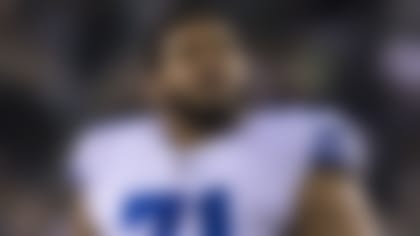The 2014 NFL Draft is just days away. As such, Around The League is breaking down the best draft class of all time for each NFC team. Look for the breakdown of each AFC team here.
NFC East
Dallas Cowboys
Thanks in part to the Herschel Walker blockbuster, Jimmy Johnson and the Cowboys combined to draft nine starters in 1991 and 1992, propelling them to victories in three of the next four Super Bowls.
For a single draft, though, it comes down to the 1964 franchise-altering class versus the 1975 haul that included Randy "The Manster" White, Thomas "Hollywood" Henderson, Bob Breunig, Herbert Scott, Mike Hegman and Pat Donovan.
The '64 draft highlighted the ingenuity of general manager Tex Schramm and VP of player personnel Gil Brandt.
Mel Renfro, one of the greatest defensive backs in history, was the best running back prospect in the draft until he lost feeling in multiple fingers following a mirror-punching incident at Oregon.
Hall of Fame wide receiver Bob Hayes, later an Olympic gold medalist billed as the "World's Fastest Human," was a track star at small-school Florida A&M.
Heisman Trophy winner and Time magazine cover boy Roger Staubauch fell to the 10th round because of his five-year commitment to the Navy. He wouldn't embark on his Hall of Fame career until age 27.
The Cowboys could have had a fourth Hall of Fame selection. In Peter Golenbock's "Cowboys Have Always Been My Heroes," Schramm disclosed that he would have drafted wide receiver Paul Warfield No. 4 overall had the Steelers not been willing to trade veteran Buddy Dial for defensive-line prospect Scott Appleton.
Fun fact: Think Jerry Jones is loyal to a fault with Jason Garrett? As the local media called for Tom Landry's head after a 13-38-4 record in four years, owner Clint Murchison Jr. rewarded his head coach with a 10-year contract extension just ahead of the 1964 draft.
New York Giants
The 1981 Lawrence Taylor draft added just one other long-term starter in guard Billy Ard. The 2007 class contributed heavily to the Super Bowl XLII title, but quickly fell off the map thereafter.
The 1984 haul wins by default then.
Carl Banks, Gary Reasons and William Roberts started for nearly a decade apiece as the Giants earned a pair of Lombardi Trophies under Bill Parcells. Jeff Hostetler was the winning quarterback in Super Bowl XXV. Lionel Manuel produced a rare 1,000-yard receiving season in an offense that skewed heavily to the run.
*Fun fact:* The 1956 class featured Hall of Fame linebacker Sam Huff, All-Pro defensive end Jim Katcavage and Pro Bowl kicker Don Chandler. Intending to quit football after a rough first training camp under Jim Lee Howell, Huff and Chandler got as far as the airport before offensive coordinator Vince Lombardi caught up, chided them and sent them back to the Giants with their tails tucked between their legs.
Philadelphia Eagles
The '86 class is highlighted by 1992 sack leader, Clyde Simmons, and SI's choice for 1991 NFL Player of the Year, Seth Joyner. The offense got a boost as well with versatile fullback Keith Byars, tailback Anthony Toney, left tackle Matt Darwin and guard Reggie Singletary.
You can read about the Eagles' obscenely talented "Gang Green" defense and the Randall Cunningham era in best-selling author Mark Bowden's "Bringing the Heat," which chronicles the 1992 season.
On a sidenote, Chip Kelly deserves plenty of credit for winning the NFC East in his debut season, but he couldn't have done it without a stacked 2012 class that includes quarterback Nick Foles, defensive end Fletcher Cox, linebacker Mychal Kendricks, nickel back Brandon Boykin and pass rusher Vinny Curry.
Fun fact: In 1987, the Eagles not only drafted shooting star Jerome Brown and middle linebacker Byron Evans, but also picked up future Hall of Fame wide receiver Cris Carter in the fourth round of the supplemental draft.
Washington Redskins
Joe Gibbs won three Super Bowls with three different quarterbacks in 10 years, thanks in part to the loaded 1981 draft class.
Hall of Famer Russ Grimm and first-round pick Mark May comprised the long-running guard duo on the Redskins' renowned "Hogs" offensive line. Not to be outdone on the nickname front, explosive deep threat Charlie Brown teamed with Hall of Famer Art Monk, Virgil Seay and Alvin Garrett in "The Fun Bunch" wide receiving corps.
For immediate impact, though, it's hard to surpass menacing pass rusher Dexter Manley, who averaged 15 sacks per season from 1983-86.
Ninth-round pick Darryl Grant and 12th-rounder Clint Didier also played key roles on a pair of Super Bowl teams.
Fun fact: Under the threat of civil rights legal action by the John F. Kennedy administration, the Redskins became the last NFL team to integrate, drafting the first black Heisman Trophy winner, Ernie Davis, in 1962.
NFC North
Chicago Bears
With the third and fourth overall picks in the 1965 draft, the Bears selected Illinois' Dick Butkus and Kansas' Gale Sayers. There's never been a more dynamic offense-defense rookie tandem.
No player took the league by storm like "The Kansas Comet," the youngest Hall of Fame inductee ever. Sayers was the NFL's best runner, most efficient receiving tailback and premier kick returner through five seasons before a left knee injury essentially ended his career in 1970.
In his first season, Sayers amassed 2,272 combined rushing, receiving and kick-return yards and 22 touchdowns, a record for a rookie.
Butkus, meanwhile, led his new team in tackles, fumble recoveries and interceptions as a rookie. Two years later, he racked up a whopping 18 sacks -- unheard of for a middle linebacker.
"The second I saw him on the field, I knew my playing days were over," Hall of Fame linebacker Bill George said. "Nobody ever looked that good before or since."
Overshadowed by the Hall of Famers, seventh-rounder Dick Gordon ended up going down as one of the best wide receivers in franchise history. His 13 touchdown receptions in 1970 still stand as a Bears single-season record.
Fun fact: The 1983 class deserves mention for producing Hall of Fame pass rusher Richard Dent, All-Pro tackle Jimbo Covert, speedster Willie Gault, longtime guards Mark Bortz and Tom Thayer and starting defensive backs Dave Duerson and Mike Richardson. There's no "Super Bowl Shuffle" without that draft.
Detroit Lions
There are strong arguments for the 1951 and 1952 drafts that produced a pair of Hall of Famers and a half-dozen other stars (including legendary broadcaster Pat Summerall), while paving the way for NFL championships in 1952, 1953 and 1957. The key to the greatest era in franchise history, though, was stealing quarterback Bobby Layne from the New York Yanks in exchange for the inimitable Camp Wilson.
The Lions' best single draft class might just be 1967, with Hall of Fame cornerback Lem Barney as the centerpiece. Not to be outdone, Mel Farr "Superstar" took Rookie of the Year honors as a multi-dimensional threat out of the backfield.
That same draft also produced Pro Bowl linebacker Paul Naumoff and six-year starting safety Mike Weger.
Fun fact: Barney and Farr provided the background vocals on Marvin Gaye's classic hit "What's Going On?," one of Motown's most widely recognized songs.
Green Bay Packers
The Packers nailed three drafts in a row from 1956-58, cushioning Vince Lombardi's arrival in 1959 after a 1-10-1 season.
Although the '56 and '57 classes turned out Hall of Famers Bart Starr, Forrest Gregg and Paul Hornung, the '58 haul was the deepest.
Hall of Famer Ray Nitschke rivaled Butkus as the NFL's premier middle linebacker of the 1960s. Fullback Jim Taylor became the first player in NFL history with five consecutive 1,000-yard rushing seasons, averaging 14 touchdowns per during that span.
That class also featured 1960s All-Decade guard Jerry Kramer as well as All-Pro linebacker Dan Currie, who made the cover of Sports Illustrated in 1961.
Those three 1950s draft classes laid the groundwork for five championships over a seven-year stretch during the 1960s.
Fun fact: Kramer teamed with pioneeringsports journalist Dick Schaap for the 1968 best-seller "Instant Replay," a first-person account of the 1968 season.
Minnesota Vikings
The 1998 and 2007 drafts are finalists because they produced Randy Moss and Adrian Peterson, two of the greatest players at their respective positions in NFL history.
For franchise impact, though, the 1967 class comes out on top for its influence on four Super Bowl clubs from 1969 through 1976.
The dominant player on Bud Grant's defense, Alan Page was a six-time All-Pro, the NFC Defensive Player of the Year in 1970, the first defensive player ever to win the NFL Most Valuable Player award (1971) and a Hall of Famer in 1988.
Not just the beating heart of the Vikings' famed "Purple People Eaters," Page is also one of the most fascinating and admirable figures in NFL history.
Cornerback Bobby Bryant also played on four NFC champions. No. 8 overall pick Gene Washington was a first-team All-Pro in 1969. Fellow wide receiver Bob Grim earned a Pro Bowl berth in 1971.
Fun fact: After retirement, Page went on to become the first African-American associate justice of the Minnesota Supreme Court.
NFC South
Atlanta Falcons
I had hoped to find a draft class that would allow me to celebrate Jerry Glanville's late 1970s "Grits Blitz" defense, but there were no worthy candidates.
The best draft class was the one that earned general manager Thomas Dimitroff the first of his two Executive of the Year awards for quickly reviving the franchise following the Michael Vick dogfighting scandal and Bobby Petrino's subsequent decision to take a powder.
Fun fact: Gearing up for the 40-yard dash at the 1989 NFL Scouting Combine, soon-to-be Falcons first-rounder Deion Sanders sauntered over to Raiders owner and noted speed-fetishist Al Davis and proclaimed, "OK, Al, we're gonna run this *juuuust* this once."
Carolina Panthers
The 2007 draft gave the Panthers pass rusher Charles Johnson, linebacker Jon Beason and center Ryan Kalil, but it doesn't quite stack up to the one that propelled John Fox's club to Super Bowl XXXVIII.
The 2001 class is headlined by Steve Smith, not just the face of the franchise for a decade but also the most underappreciated superstar receiver of his generation.
One of the NFL's premier middle linebackers before concussions prematurely ended his career, Dan Morgan recorded a game-high 18 tackles (Or 25, if you believe Panthers coaches) in the Super Bowl loss to the Patriots.
Three-time All-Pro Kris Jenkins was one of the most disruptive interior defenders of his era, teaming with end Mike Rucker to form an imposing defensive-line tandem in Charlotte.
Fun fact: Three of the first four first-round draft picks in franchise history went on to become a recovering alcoholic (Kerry Collins), a murder-for-hire mastermind (Rae Carruth) and an out-of-control drug addict (Jason Peter), respectively.
New Orleans Saints
The 2006 class featuring Reggie Bush, Marques Colston, Jahri Evans and Roman Harper helped revitalize New Orleans in the wake of Hurricane Katrina, but the 1981 haul is a sneaky pick as one of the must fruitful in NFL history.
Second-round pick Rickey Jackson became the Saints' first Hall of Fame selection after racking up 128 sacks as the most decorated of the No. 1 linebacker corps of all time.
Early in his career, Jackson was outshined by first overall pick George Rogers, who set an NFL rookie record with 1,674 rushing yards. Rogers' running ability is credited with revitalizing a moribund franchise.
The defensive-end duo of Frank Warren and Jim Wilks contributed 98 sacks while playing more than a dozen seasons each in the Big Easy. The '83 draft also produced a 12-year starter at tight end (Hoby Brenner), six-year starter at cornerback (Johnnie Poe), a four-year starter at safety (Russell Gary) and a change-of-pace back with a career average of 5.4 yards per carry (Hokie Gajan).
Fun fact: You know that Mike Ditka parted with the Saints' entire 1998 draft for the opportunity to grab Ricky Williams. But did you know Bengals owner Mike Brown' rejected Ditka's offer of six 1999 draft picks plus two more first-round picks and a second-rounder because he couldn't pass up Akili Smith?
Tampa Bay Buccaneers
Much like the Ravens in the AFC, there's only one possible answer to this question. Prior to the drafting of Hall of Famers Warren Sapp and Derrick Brooks in 1996, the Buccaneers had suffered through 13 consecutive losing seasons.
Tony Dungy arrived on the scene with his Tampa-2 defense, in which Sapp, Brooks, safety John Lynch, cornerback Ronde Barber and linebacker Hardy Nickerson thrived.
Sapp and Brooks went on to become the prototype three-technique tackle and weakside linebacker, respectively, as Cover 2 schemes became all the rage for nearly a decade. Starting in 1997, the Bucs made the playoffs in five of six seasons, finally hoisting the Lombardi Trophy in 2003.
By at least one statistical measure, the 2002 Bucs defense is the best in NFL history.
Fun fact: The king of one-liners, original Bucs coach John McKay provided one of the best quotes in sports history when asked about his team's execution after a loss. "I think it's a good idea," McKay quipped.
NFC West
Arizona Cardinals
For a good chunk of their history, the Cardinals were an NFL laughingstock -- a poorly run franchise to which established players dreaded being traded.
In the midst of all that failure, though, the organization produced stout draft classes in 1952 (Ollie Matson), 1962 (Larry Wilson, Charley Johnson), 1963 (Jackie Smith, Larry Stallings), 1971 (Dan Dierdorf, Mel Gray) and 1979 (Ottis Anderson, Roy Green).
Although Kurt Warner garners much of the credit for the Cardinals' lone Super Bowl appearance, the backbone of that team was acquired through the 2004 draft.
Future Hall of Famer Larry Fitzgerald is the proud owner of the most prolific postseason run by a wide receiver in history, racking up 30 receptions for 546 yards and seven touchdowns in four playoff games.
That class also features three-time Pro Bowl defensive lineman Darnell Dockett, leading tackler Karlos Dansby and defensive end Antonio Smith.
Fun fact: The Cardinals and Bears -- both based out of Illinois in 1920 -- are the only remaining franchises from the original American Professional Football Association (APFA) created in Ralph Hay's hupmobile showroom. The Bears were born as the Decatur Staleys, leaving the Cardinals as the NFL's longest-running franchise nickname.
San Francisco 49ers
After guiding the franchise to Super Bowl victories in 1981 and 1984, Walsh executed a series of masterful trades leading up to the 1986 draft, turning eight picks into 14.
That impressive haul produced more than a half-dozen contributors to the next three Super Bowls in 1988, 1989 and 1994.
Five-time Super Bowl champion pass rusher Charles Haley headlined a class that also featured versatile fullback Tom Rathman, playmaking wide receiver John Taylor, offensive tackle Steve Wallace and key defenders Tim McKyer, Don Griffin, Kevin Fagan and Larry Roberts.
The 1986 draft was the bridge to a dynasty viewed by some as the greatest in NFL history.
Fun fact: Walsh originally targeted Morehead State's Phil Simms and Clemson's Steve Fuller in 1979 before settling on Joe Montana in the third round. While working out Fuller at Clemson, Walsh serendipitously discovered the quarterback's roommate, 10th-round pick Dwight Clark.
Seattle Seahawks
With apologies to the 1990 draft featuring Hall of Famer Cortez Kennedy and productive running back Chris Warren, the 2010 class is already the strongest in franchise history.
Forming the league's most-imposing safety tandem, Earl Thomas and Kam Chancellor led a historically great pass defense that stonewalled the Broncos' record-breaking offense in Super Bowl XLVIII.
The 2010 draft also featured Pro Bowl left tackle Russell Okung, top-notch nickelback Walter Thurmond, wide receiver Golden Tate -- all of whom contributed to the lone Lombardi Trophy in Seahawks history.
St. Louis Rams
I couldn't bring myself to nominate a draft class prior to 1950, at a time when college stars were still opting to go into fields such as teaching rather than taking a chance on an NFL career. It's worth noting, though, that the 1945 Cleveland Rams jump-started the most successful run in franchise history by drafting Hall of Famers Elroy "Crazy Legs" Hirsch and Tom Fears.
Finalists for the modern era came down to 1957 (Lamar Lundy, Jack Pardee), 1961 (Deacon Jones, Marlin McKeever), 1962 (Merlin Olsen, Roman Gabriel), 1971 (Jack Youngblood, Isiah Robertson), 1975 (Dennis Harrah, Doug France) and 1983 (Eric Dickerson, Henry Ellard).
The one that led to the most immediate success was the 1977 class featuring 1980 UPI Defensive Player of the Year, Nolan Cromwell.
Third-round running back Wendell Tyler led the NFL with 5.1 yards per carry in 1979 while fourth-rounder Vince Ferragamo took over as the starting quarterback en route to a Super Bowl XIV berth versus the Steelers.
Fun fact:Fed up with Baltimore in 1972, owner Carroll Rosenbloom executed a tax-free swap of franchises with newly installed Los Angeles Rams owner Robert Irsay.
The latest "Around The League Podcast" breaks out the crystal ball and predicts the potential surprises that could shake up the NFL Draft.












